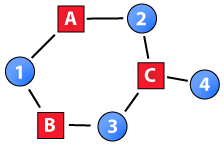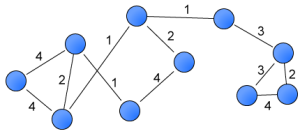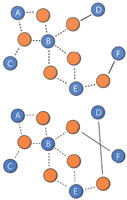Posts tagged ‘embeddedness’
Article: Triadic closure in two-mode networks: Redefining the global and local clustering coefficients
 A paper called “Triadic closure in two-mode networks: Redefining the global and local clustering coefficients” that I have authored will be published in the special issue of Social Networks on two-mode networks (2012).
A paper called “Triadic closure in two-mode networks: Redefining the global and local clustering coefficients” that I have authored will be published in the special issue of Social Networks on two-mode networks (2012).
As the vast majority of network measures are defined for one-mode networks, two-mode networks often have to be projected onto one-mode networks to be analyzed. A number of issues arise in this transformation process, especially when analyzing ties among nodes’ contacts. For example, the values attained by the global and local clustering coefficients on projected random two-mode networks deviate from the expected values in corresponding classical one-mode networks. Moreover, both the local clustering coefficient and constraint (structural holes) are inversely associated to nodes’ two-mode degree. To overcome these issues, this paper proposes redefinitions of the clustering coefficients for two-mode networks.
Local clustering coefficient for two-mode networks
 Similar to the motivation of the global clustering coefficient that I proposed in Clustering in two-mode networks, the local clustering coefficient is biased if applied to a projection of a two-mode network. It is biased in the sense that the randomly expected value is not obtained on the projection of a random two-mode network. To overcome this methodological bias, I redefine the local clustering coefficient for two-mode networks. The new coefficient is a mix between the global clustering coefficient for two-mode networks and Barrat’s (2004) local coefficient for a weighted one-mode network. The coefficient is tested on Davis’ (1940) Southern Women dataset.
Similar to the motivation of the global clustering coefficient that I proposed in Clustering in two-mode networks, the local clustering coefficient is biased if applied to a projection of a two-mode network. It is biased in the sense that the randomly expected value is not obtained on the projection of a random two-mode network. To overcome this methodological bias, I redefine the local clustering coefficient for two-mode networks. The new coefficient is a mix between the global clustering coefficient for two-mode networks and Barrat’s (2004) local coefficient for a weighted one-mode network. The coefficient is tested on Davis’ (1940) Southern Women dataset.
Clustering in two-mode networks
 Many network dataset are by definition two-mode networks. Yet, few network measures can be directly applied to them. Therefore, two-mode networks are often projected onto one-mode networks by selecting a node set and linking two nodes if they were connected to common nodes in the two-mode network. This process has a major impact on the level of clustering in the network. If three or more nodes are connected to a common node in the two-mode network, the nodes form a fully-connected clique consisting of one or more triangles in the one-mode projection. Moreover, it produces a number of modeling issues. For example, even a one-mode projection of a random two-mode network with same number of nodes and ties will have a higher clustering coefficient than the randomly expected value. This post represents an attempt to overcome this issue by redefining the clustering coefficient so that it can be calculated directly on the two-mode structure. I illustrate the benefits of such an approach by applying it to two-mode networks from four different domains: event attendance, scientific collaboration, interlocking directorates, and online communication.
Many network dataset are by definition two-mode networks. Yet, few network measures can be directly applied to them. Therefore, two-mode networks are often projected onto one-mode networks by selecting a node set and linking two nodes if they were connected to common nodes in the two-mode network. This process has a major impact on the level of clustering in the network. If three or more nodes are connected to a common node in the two-mode network, the nodes form a fully-connected clique consisting of one or more triangles in the one-mode projection. Moreover, it produces a number of modeling issues. For example, even a one-mode projection of a random two-mode network with same number of nodes and ties will have a higher clustering coefficient than the randomly expected value. This post represents an attempt to overcome this issue by redefining the clustering coefficient so that it can be calculated directly on the two-mode structure. I illustrate the benefits of such an approach by applying it to two-mode networks from four different domains: event attendance, scientific collaboration, interlocking directorates, and online communication.
tnet: Software for Analysing Weighted Networks
 tnet is a package written in R that can calculate weighted social network measures. Almost all of the ideas posted on this blog are related to weighted networks as, I believe, taking into consideration tie weights enables us to uncover and study interesting network properties. Not only are few social network measures applicable to weighted networks, but there is also a lack of software programmes that can analyse this type of networks. In fact, there are no open-source programmes. This hinders the use and development of weighted measures. tnet represents a first step towards creating such a programme. Through this platform, weighted network measures can easily be applied, and new measures easily implemented and distributed.
tnet is a package written in R that can calculate weighted social network measures. Almost all of the ideas posted on this blog are related to weighted networks as, I believe, taking into consideration tie weights enables us to uncover and study interesting network properties. Not only are few social network measures applicable to weighted networks, but there is also a lack of software programmes that can analyse this type of networks. In fact, there are no open-source programmes. This hinders the use and development of weighted measures. tnet represents a first step towards creating such a programme. Through this platform, weighted network measures can easily be applied, and new measures easily implemented and distributed.
Weighted Rich-club Effect: A more appropriate null model for scientific collaboration networks
 In this post, I extend the Weighted Rich-club Effect by suggesting and testing a different null model for the scientific collaboration network (Newman, 2001). This network is a two-mode network, which becomes an undirected one-mode network when projected. In the paper, we compared the observed weighted rich-club coefficient with the one found on random networks. The random networks were constructed by a null model defined for directed networks when prominence was based on node strength. Therefore, we created a directed network from the undirected scientific collaboration network by linking connected nodes with two directed ties that had the same weight. The null model consisted in reshuffling the tie weights attached to out-going ties for each node. However, this local reshuffling broke the weight symmetry of the two directed ties between connected nodes. The null model proposed in this post is based on the randomisation of the two-mode network before projecting it onto a one-mode network. By randomising before projecting, we are able to randomise a network while keeping the symmetry of weights.
In this post, I extend the Weighted Rich-club Effect by suggesting and testing a different null model for the scientific collaboration network (Newman, 2001). This network is a two-mode network, which becomes an undirected one-mode network when projected. In the paper, we compared the observed weighted rich-club coefficient with the one found on random networks. The random networks were constructed by a null model defined for directed networks when prominence was based on node strength. Therefore, we created a directed network from the undirected scientific collaboration network by linking connected nodes with two directed ties that had the same weight. The null model consisted in reshuffling the tie weights attached to out-going ties for each node. However, this local reshuffling broke the weight symmetry of the two directed ties between connected nodes. The null model proposed in this post is based on the randomisation of the two-mode network before projecting it onto a one-mode network. By randomising before projecting, we are able to randomise a network while keeping the symmetry of weights.
Thesis: Structure and Evolution of Weighted Networks
I have now completed my Ph.D. at the School of Business and Management of Queen Mary College, University of London. My Ph.D. programme was defined around a number of projects, which drew on, and extended, recent theoretical and methodological advances in network science. The projects that were concerned with weighted networks and longitudinal networks were outlined and critically discussed in my thesis (Structure and Evolution of Weighted Networks). The entire thesis, except Appendix C which is outdated, is available on the Publication > Thesis-page.
Acknowledgements
The theme of this thesis is interdependence among elements. In fact, this thesis is not just a product of myself, but also of my interdependence with others. Without the support of a number of people, it would not have been possible to write. It is my pleasure to have the opportunity to express my gratitude to many of them here.
For my academic achievements, I would like to acknowledge the constant support from my supervisors. In particular, I thank Pietro Panzarasa for taking an active part of all the projects I have worked on. I have also had the pleasure to collaborate with people other than my supervisors. I worked with Vittoria Colizza and Jose J. Ramasco on the analysis and method presented in Chapter 2, Kathleen M. Carley on an empirical analysis of the online social network used throughout this thesis, and Martha J. Prevezer on a project related to knowledge transfer in emerging countries. In addition to these direct collaborations, I would also like to thank Filip Agneessens, Sinan Aral, Steve Borgatti, Ronald Burt, Mauro Faccioni Filho, Thomas Friemel, John Skvoretz, and Vanina Torlo for encouragement and helpful advice. In particular, I would like to thank Tom A. B. Snijders and Klaus Nielsen for insightful reading of this thesis and many productive remarks and suggestions. I have also received feedback on my work at a number of conferences and workshops. I would like to express my gratitude to the participants at these.
On a social note, I would like to thank John, Claudius, and my family for their continuing support. Without them I would have lost focus. My peers and the administrative staff have also been a great source of support. In particular, I would like to extend my acknowledgements to Mariusz Jarmuzek, Geraldine Marks, Roland Miller, Jenny Murphy, Cathrine Seierstad, Lorna Soar, Steven Telford, and Eshref Trushin.
Are triangles made up by strong ties?
 A key assumption of Granovetter’s (1973) Strength of Weak Ties theory is that strong ties are embedded by being part of triangles, whereas weak ties are not embedded by being created towards disconnected nodes. This assumption have been tested by calculating the traditional clustering coefficient on binary networks created with increasing cut-off parameters (i.e., creating a series of binary networks from a weighted network where ties with a weight greater than a cut-off parameter is set to present and the rest removed). Contrarily to theories of strong ties and embeddedness, these methods generally showed that the clustering coefficient decreased as the cut-off parameter increased. However, the binary networks were not comparable with each other as they had a different number of ties. Another way of testing this assumption is to take the ratio between the weighted global clustering coefficient and the traditional coefficient measured on networks where all ties are considered present. Thus, the number of ties is maintained. This post highlights this feature and empirically tests it on a number of publically available weighted network datasets.
A key assumption of Granovetter’s (1973) Strength of Weak Ties theory is that strong ties are embedded by being part of triangles, whereas weak ties are not embedded by being created towards disconnected nodes. This assumption have been tested by calculating the traditional clustering coefficient on binary networks created with increasing cut-off parameters (i.e., creating a series of binary networks from a weighted network where ties with a weight greater than a cut-off parameter is set to present and the rest removed). Contrarily to theories of strong ties and embeddedness, these methods generally showed that the clustering coefficient decreased as the cut-off parameter increased. However, the binary networks were not comparable with each other as they had a different number of ties. Another way of testing this assumption is to take the ratio between the weighted global clustering coefficient and the traditional coefficient measured on networks where all ties are considered present. Thus, the number of ties is maintained. This post highlights this feature and empirically tests it on a number of publically available weighted network datasets.
Article: Clustering in Weighted Networks
 A paper called “Clustering in Weighted Networks” that I have co-authored will be published in Social Networks. Although many social network measures exist for binary networks and many theories differentiate between strong and weak ties, few measures have been generalised so that they can be applied to weighted networks and retain the information encoded in the weights of ties. One of these measures is the global clustering coefficient, which measures embeddedness or, more specifically, the likelihood of a triplet being closed by a tie so that it forms a triangle. This article proposes a generalisation of this key network measure to weighted networks.
A paper called “Clustering in Weighted Networks” that I have co-authored will be published in Social Networks. Although many social network measures exist for binary networks and many theories differentiate between strong and weak ties, few measures have been generalised so that they can be applied to weighted networks and retain the information encoded in the weights of ties. One of these measures is the global clustering coefficient, which measures embeddedness or, more specifically, the likelihood of a triplet being closed by a tie so that it forms a triangle. This article proposes a generalisation of this key network measure to weighted networks.
Article: Patterns and Dynamics of Users’ Behaviour and Interaction: Network Analysis of an Online Community
 A paper called “Patterns and Dynamics of Users’ Behaviour and Interaction: Network Analysis of an Online Community” that I have co-authored will be published in the Journal of the American Society for Information Science and Technology (JASIST). In this paper, we studied the evolution of a variety of properties in an online community, including how users create, reciprocate, and deepen relationships with one another, variations in users’ gregariousness and popularity, reachability and typical distances among users, and the degree of local redundancy in the community.
A paper called “Patterns and Dynamics of Users’ Behaviour and Interaction: Network Analysis of an Online Community” that I have co-authored will be published in the Journal of the American Society for Information Science and Technology (JASIST). In this paper, we studied the evolution of a variety of properties in an online community, including how users create, reciprocate, and deepen relationships with one another, variations in users’ gregariousness and popularity, reachability and typical distances among users, and the degree of local redundancy in the community.
Weighted local clustering coefficient
 The generalisation of the local clustering coefficient to weighted networks by Barrat et al. (2004) considers the value of a triplet to be the average of the weights attached to the two ties that make up the triplet. In this post, I suggest three additional methods for defining the triplet value.
The generalisation of the local clustering coefficient to weighted networks by Barrat et al. (2004) considers the value of a triplet to be the average of the weights attached to the two ties that make up the triplet. In this post, I suggest three additional methods for defining the triplet value.
Article: Prominence and control: The weighted rich-club effect
A paper called Prominence and control: The weighted rich-club effect that I have co-authored was published in Physical Review Letters (PRL). In this paper, we proposed a new general framework for studying the tendency of prominent nodes to direct their strongest ties toward each other.
 RSS feed
RSS feed